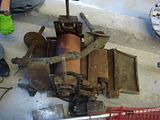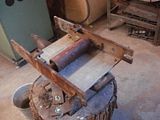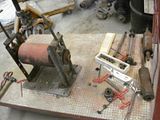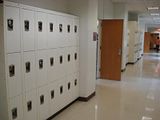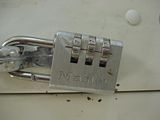Control+Alt+Robot
Gallery
Saturday, February 18, 2012
Building a Printing Press
Taking the machine back to the workshop, me and a friend, Mark Reedy (basically my studio assistant in the project, ha-ha), started to take the thing apart so we could clean off the beautiful light coating of rust and mud that build up over its time in the elements. A wondrous occasion I can only describe as “Man Time”, a bonding experience where guys build stuff.
So far the progress is smooth going, with only a few hitches concerning the workshop’s lack of tools, but it seems we have all the parts we’ll need to make the press, which is quite exciting. The downside, however, is that the project doesn’t particularly pertain to the assignment at hand, so I’ll have to devote the majority of my time and effort to a second project, pushing the progress of this one to one day a week we’ve set aside.
I plan to document the progress of the project on this blog with images and the occasional shaky-cam video, so stay tuned.
Tuesday, September 20, 2011
"6"

In a stint of delirium, I went down a hallway outside the room where I was waiting for my class and changed all the locks of the lockers to six. I call the piece “6”. Is this art? I think so, if you’re going to call placing cans of cat food on watermelons art. In your face Gabriel Orozco!

Tuesday, May 10, 2011
Wood and Metal




Here’s my little tribal man, influenced by Chinese mingqi burial figures.

Here’s my zoomorphic rat, also inspired by Asian art.
Saturday, March 5, 2011
Atop "Star-Crossed"

The sculpture “Star-Crossed” by Nancy Holt, is behind the art museum in
Sunday, January 2, 2011
"Happy Cows, Happy Meals" - Plaster Cast Sculpture
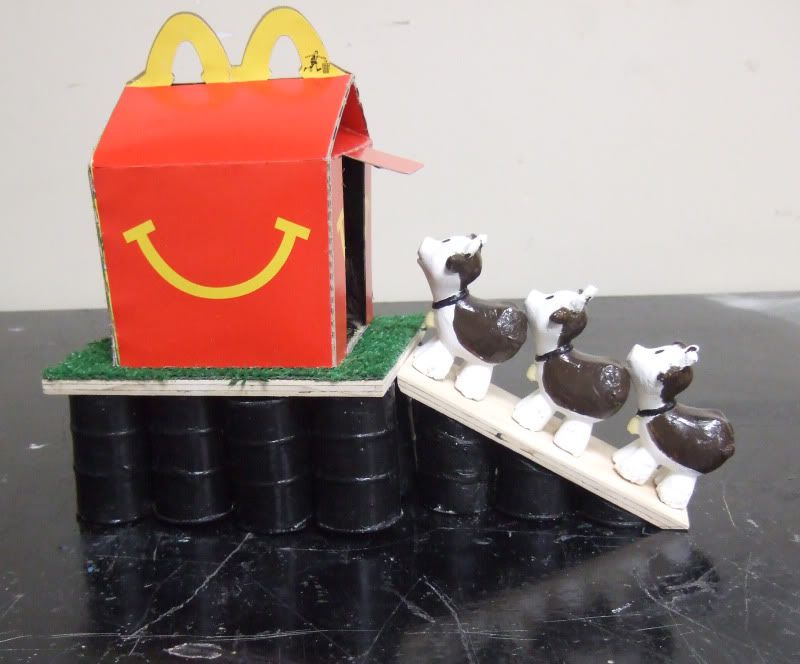
I wanted to do something with barrels, barrels and cars. Something about pollution and how fossil fuel wasn’t a really sustainable fuel source. I had an idea that involved a pyramid made of barrels with a Hummer on top, but the sketch I did wasn’t really interesting, and was too simple. I also had made a mold of a toy cow, so I tried to find a way to relate the two, the cow and the oil barrels. Nothing came to mind, until I was referred to the book, “The Omnivore’s Dilemma” by Michael Pollan, and how in the book it was revealed that it took one barrel, per cow, to raise it, feed it, transport it to slaughter and to restaurant, and to cook it. This I had never heard of, but now I had a topic for my piece.

It’s said that America consumes more beef than any other country in the world, and when people think mass production of beef, they think hamburgers, and when they think hamburgers, they get hungry for Mac Donald’s. Mac Donald’s is one of the largest producers of hamburgers in the world, selling Happy Meals in countries all over the world. Obviously hundreds of thousands of gallons of oil a year is used to transport this beef around the world.
 The oil barrels are the base of the piece, representing all the gallons of oil used to transport the beef to market and restaurants. The plastic grass surrounding the box implies the ground, with the barrels underneath, insinuating the origin of the oil. The three plaster cows are casted from a mold of a plastic child’s toy, making the piece cynical yet innocent, also representing the free toy in every child’s meal, 90% of the reason for buying the meal in the first place, the food, which took thousands of dollars to get there, becoming second. The cows are being led up a ramp into a red, smiling happy meal box, almost like if it were a herd of cattle being led into a slaughter house, and the mouth of a smiling child. Inside the happy meal slaughterhouse is a hung cow carcass, cleaned and prepared for freezing and shipment, ready to be part of a child’s Happy Meal.
The oil barrels are the base of the piece, representing all the gallons of oil used to transport the beef to market and restaurants. The plastic grass surrounding the box implies the ground, with the barrels underneath, insinuating the origin of the oil. The three plaster cows are casted from a mold of a plastic child’s toy, making the piece cynical yet innocent, also representing the free toy in every child’s meal, 90% of the reason for buying the meal in the first place, the food, which took thousands of dollars to get there, becoming second. The cows are being led up a ramp into a red, smiling happy meal box, almost like if it were a herd of cattle being led into a slaughter house, and the mouth of a smiling child. Inside the happy meal slaughterhouse is a hung cow carcass, cleaned and prepared for freezing and shipment, ready to be part of a child’s Happy Meal.
(Photo Credit to Roscoe Wilson)
Thursday, December 30, 2010
(Untitled) - Wood Sculpture

I didn’t have a plan going into the wood project. I did some preliminary sketches but they didn’t relate to what I eventually produced. I went with my feelings, and started cutting strips of wood. I tried to make interesting shapes, and ultimately just had fun without any vision in mind. When I had a good pile of strips, I played with the pieces, seeing how they related to each other; what looked nice and interesting. I wanted the piece to look natural and organic, so I decided not to use any screws or adhesives, and just stuck to peg and hole methods of holding the piece together. I sanded several of the pieces in order to reduce kinks, and make it look like each piece flowed into the next without any transitions.
What I ended up with was abstract, and had no real meaning or inspiration. It was a just go-with-my-feelings piece, but I was thinking of the way fish feed when I was constructing it, so maybe there was some subconscious contributions to the way the sculpture turned out. It does resemble some sort of tentacled mass, reminiscent of some abomination born out of Lovecraft’s mind, reaching up from the depths of the sea.
Tuesday, October 5, 2010
Recycling a Plate
Something that I’ve done in the past is resurface old/ abandoned etching plates left by past art students, by scraping off the old image. Usually these plates would remain in a drawer in the art room forever, but once resurfaced I can use the plate again to etch my own image onto it. This reflects my passion for recycling, and my pet peeve of things not being utilized to their full potential.
The process of resurfacing a plat involves me using a scrapper, a triangular-prism shaped tool to scrape down the surface of the plate until it’s even with the image that they’ve etched into it. This process is not only time consuming but demands a lot of physical work, bordering on arduous. The result is a free plate that I would had to have paid for otherwise, and the relief of another plate that would have ended up sitting there in that drawer, forever, until it was eventually thrown away.
The most current plate that I’ve taken to the task of resurfacing is already almost completely blank. Two days of scrapping and the image on the plate is almost completely erased. Making prints of the plate lets me know what area of the plate needs to be worked on further.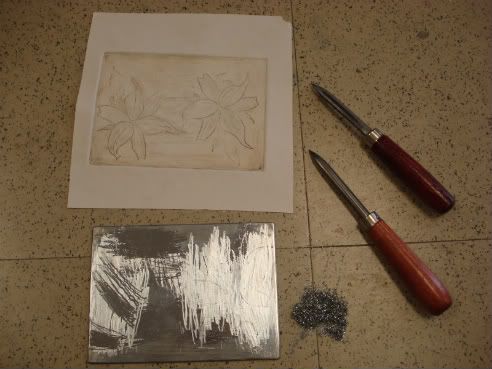
Even though scraping only take off a small bit off at a time, I can amass quite a sizable amount of shaving after a few hours.
 Here is a print at the beginning of the day, and a few hours of scrapping after.
Here is a print at the beginning of the day, and a few hours of scrapping after.
In every consecutive print, the image becomes fainter and fainter, until the image is finally gone, and the plate is blank once more, ready for a new image to be etched into it. 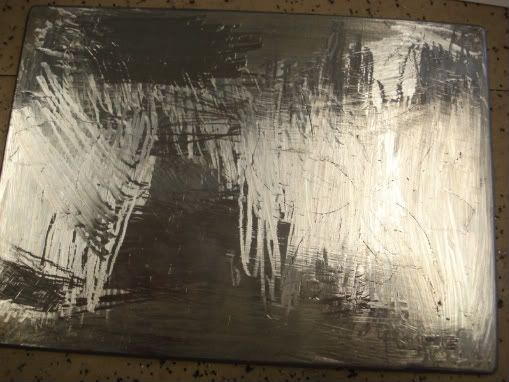
About Me

- Matt O.
- I am the creator of Lego stop-motion animation Shadow of the Brick, go watch it on my Youtube channel Green Dragon Films. I also play old games on the YouTube channel Matt's Gameplay. I also make art involving robots and other weird science themes. Fallow me on Twitter: @ControlAltRobot
